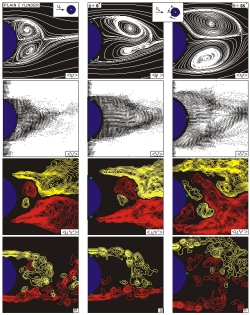You are here
Home ›Near-Wake Vortex Patterns due to Helical Windings (Strakes) about a Cylinder
Near-wake vortex patterns due to helical windings (strakes) about a cylinder. The left column of images, which represents the case of a plain cylinder, shows patterns of time-averaged streamline topology <Ψ>, velocity <v>, Reynolds stress <u'v'> , and vorticity <ω>. In the middle column of images, the cross-sectional cut of the helical winding pattern is such that q = 0°. The pattern of streamline topology shows asymmetry of the near-wake vortices, which are located further downstream from the base than for the case of the plain cylinder. Furthermore, patterns of both <u'v'> and <ω> correspond to downstream movement of the vortex pattern. In the right column of images, the helical winding is at θ = 65°, and the width and symmetry of the near-wake region are substantially larger. The pattern of instantaneous vorticity ω shows that large-scale clusters of vorticity are formed in the near-wake; they contribute to the high levels of <u'v'> close to the base of the cylinder.
It is well known that the fluctuating lift and base pressure coefficients on a circular cylinder undergo large changes with increasing Reynolds number over the range extending approximately from 103 to 104. These variations of the loading, obtained in previous investigations, are physically interpreted herein with wholefield patterns of the flow structure. A central feature is the earlier onset of small-scale vortical structures in the separating shear layer with increasing Reynolds number. These structures substantially enhance the level of Reynolds stress correlation in the separating shear layer. In turn, it is demonstrated that this enhancement is associated with: the onset of pronounced cross-stream velocity, i.e., entrained flow into the shear layer, which is particularly evident in the base region at higher values of Reynolds number; and the onset of a negative pocket of streamwise velocity, which migrates upstream with increasing Reynolds number. The overall consequence of these alterations of the near-wake is a substantial decrease in formation length of the large-scale Kármán vortex, which is interpreted via patterns of phase-referenced instantaneous velocity and time-averaged vorticity.

